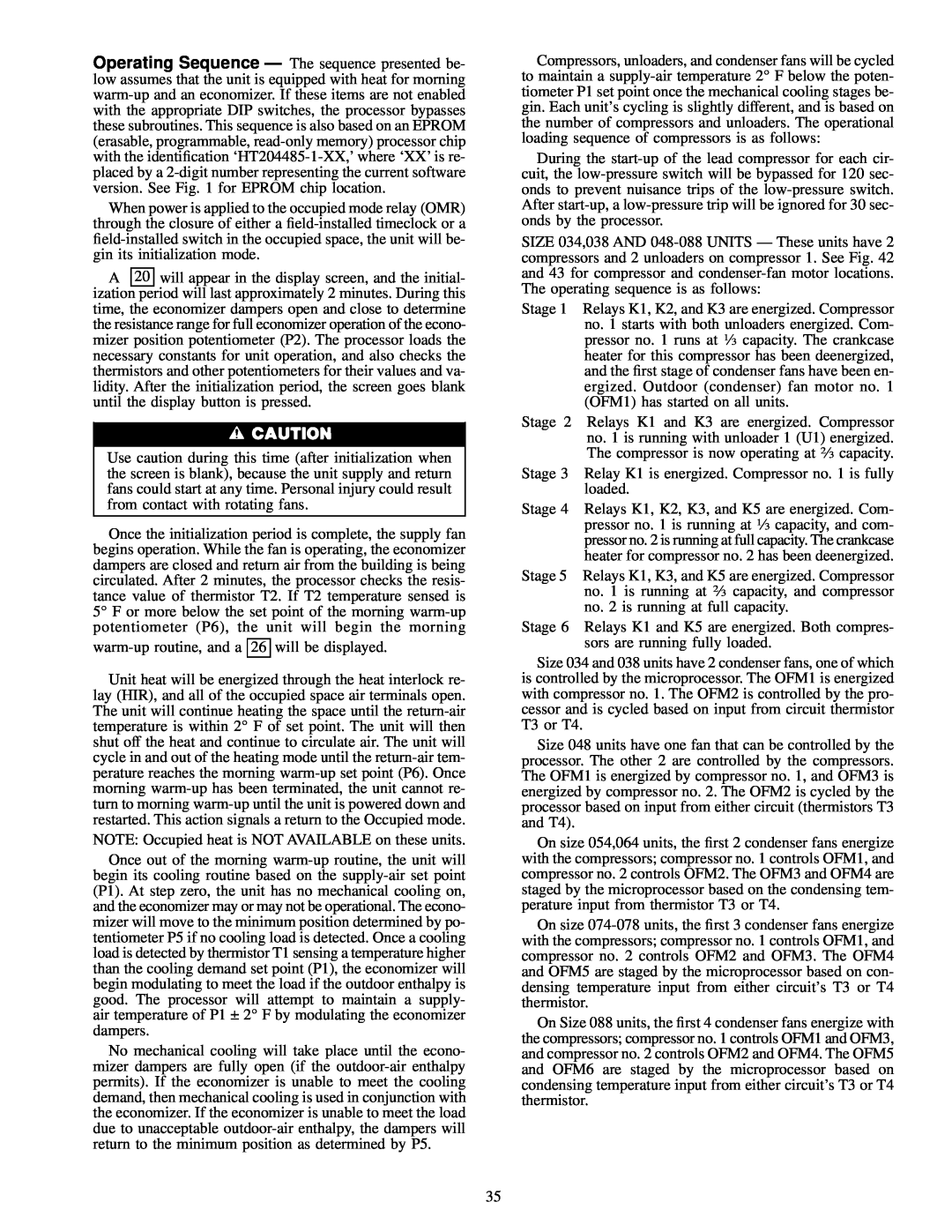
Operating Sequence Ð The sequence presented be- low assumes that the unit is equipped with heat for morning
When power is applied to the occupied mode relay (OMR) through the closure of either a
A20 will appear in the display screen, and the initial- ization period will last approximately 2 minutes. During this time, the economizer dampers open and close to determine the resistance range for full economizer operation of the econo- mizer position potentiometer (P2). The processor loads the necessary constants for unit operation, and also checks the thermistors and other potentiometers for their values and va- lidity. After the initialization period, the screen goes blank until the display button is pressed.
Use caution during this time (after initialization when the screen is blank), because the unit supply and return fans could start at any time. Personal injury could result from contact with rotating fans.
Once the initialization period is complete, the supply fan begins operation. While the fan is operating, the economizer dampers are closed and return air from the building is being circulated. After 2 minutes, the processor checks the resis- tance value of thermistor T2. If T2 temperature sensed is 5° F or more below the set point of the morning
warm-up routine, and a 26 will be displayed.
Unit heat will be energized through the heat interlock re- lay (HIR), and all of the occupied space air terminals open. The unit will continue heating the space until the
NOTE: Occupied heat is NOT AVAILABLE on these units.
Once out of the morning
No mechanical cooling will take place until the econo- mizer dampers are fully open (if the
Compressors, unloaders, and condenser fans will be cycled to maintain a
During the
SIZE 034,038 AND
Stage 1 Relays K1, K2, and K3 are energized. Compressor no. 1 starts with both unloaders energized. Com- pressor no. 1 runs at 1¤3 capacity. The crankcase heater for this compressor has been deenergized, and the ®rst stage of condenser fans have been en- ergized. Outdoor (condenser) fan motor no. 1 (OFM1) has started on all units.
Stage 2 Relays K1 and K3 are energized. Compressor no. 1 is running with unloader 1 (U1) energized. The compressor is now operating at 2¤3 capacity.
Stage 3 Relay K1 is energized. Compressor no. 1 is fully loaded.
Stage 4 Relays K1, K2, K3, and K5 are energized. Com- pressor no. 1 is running at 1¤3 capacity, and com- pressor no. 2 is running at full capacity. The crankcase heater for compressor no. 2 has been deenergized.
Stage 5 Relays K1, K3, and K5 are energized. Compressor no. 1 is running at 2¤3 capacity, and compressor no. 2 is running at full capacity.
Stage 6 Relays K1 and K5 are energized. Both compres- sors are running fully loaded.
Size 034 and 038 units have 2 condenser fans, one of which is controlled by the microprocessor. The OFM1 is energized with compressor no. 1. The OFM2 is controlled by the pro- cessor and is cycled based on input from circuit thermistor T3 or T4.
Size 048 units have one fan that can be controlled by the processor. The other 2 are controlled by the compressors. The OFM1 is energized by compressor no. 1, and OFM3 is energized by compressor no. 2. The OFM2 is cycled by the processor based on input from either circuit (thermistors T3 and T4).
On size 054,064 units, the ®rst 2 condenser fans energize with the compressors; compressor no. 1 controls OFM1, and compressor no. 2 controls OFM2. The OFM3 and OFM4 are staged by the microprocessor based on the condensing tem- perature input from thermistor T3 or T4.
On size
On Size 088 units, the ®rst 4 condenser fans energize with the compressors; compressor no. 1 controls OFM1 and OFM3, and compressor no. 2 controls OFM2 and OFM4. The OFM5 and OFM6 are staged by the microprocessor based on condensing temperature input from either circuit's T3 or T4 thermistor.
35
